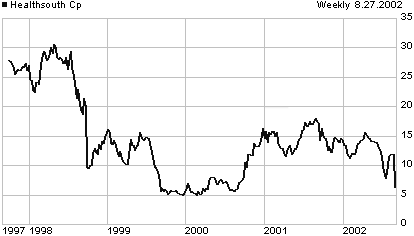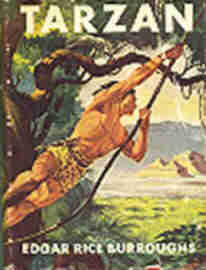 On
a 27 August:
On
a 27 August: 2003 At 09:51 UT Mars is at its closest to the Earth since 12 September 57'617 BC: 55'760'000 km. For several weeks it has appeared brighter than any star or planet except Venus. It will not be that close until 28 August 2287.
2002 HealthSouth Corporation (HRC) announces plans to split in two to shield its strong surgery center division from expected earnings weakness in its rehabilitation services, due to changes in Medicare [next story]. The stock of Healthsouth Corporation (HRC) is downgraded by UBS Warburg from Strong Buy to Buy. On the New York Stock Exchange, HRC drops from its previous close of $11.97 to an intraday low of $6.24 and closes at $6.71. It had started trading on 29 September 1997, at $26.63, and then rose to $30.56 on 27 April 1998. From there it dropped as low as $4.81 on 27 December 1999, but then recovered to as much as $18.48 on 04 September 2001. [5~year price chart >]
2002 Older people in 23 states of the US will have a new option in Medicare: managed care plans that offer prescription drug coverage and are more flexible than HMOs, much like those chosen by many people under age 65. Under an experimental plan announced today, up to 11 million Medicare participants in 23 states can sign up for preferred provider organizations, where coverage is cheap as long as patients use doctors and hospitals that are on the insurance company's list. Unlike health maintenance organizations, PPOs allow subscribers to visit doctors outside the network, but they have to pay extra. All 33 health plans participating in the program intend to offer prescription drug coverage. The traditional Medicare program, where patients can see any doctor they want, has never offered drug coverage outside of hospitals. So older people who want coverage have been forced to buy expensive supplementary coverage or join HMOs. Officials hope the new plans prove both popular with seniors and financially viable for insurance companies, who have pulled out of the Medicare HMO program in droves. Health and Human Services Secretary Tommy Thompson noted that nearly half of all people in the US under age 65 are in PPOs. "If this is so popular with Americans under 65, we should provide the same choices for our seniors," he said. Congress has been debating how to add prescription drug coverage to Medicare so that all participants can get help with their drug bills. Disagreements over how to structure the program and how much to spend have tied up the issue, and no bill is expected to pass this year. Many seniors signed up for HMOs to get drug coverage, but those plans have complained that they didn't get enough money to cover participants and many have dropped out. About 12% of Medicare participants remain in HMOs now. Under the pilot program announced Tuesday, plans agree to offer coverage for at least three years. They will typically be paid more per enrollee than health plans offering HMOs are paid. If spending on participants winds up being significantly higher or significantly lower, the loss or the savings will be shared with the federal government. Seniors can sign up for the new plans beginning in November 2002, with coverage starting on 01 January 2003. The option will be available to about 11 million Medicare participants. Plans intend to offer PPOs in all or parts of 23 states: Alabama, Arizona, California, Florida, Illinois, Indiana, Kansas, Kentucky, Louisiana, Maryland, Missouri, North Carolina, Nevada, New Jersey, New York, Ohio, Oregon, Pennsylvania, Rhode Island, Tennessee, Virginia, West Virginia and Washington.
| 2002 Evidence for van der Waals adhesion in gecko setae
The Proceedings of the National Acadamy of Science Online publish a study of one of the most versatile and effective adhesives known, evolved by geckos. The mechanism of dry adhesion in the millions of setae on the toes of geckos has been the focus of scientific study for over a century. The researchers provide the first direct experimental evidence for dry adhesion of gecko setae by van der Waals forces, and reject the use of mechanisms relying on high surface polarity, including capillary adhesion. The toes of live Tokay geckos were highly hydrophobic, and adhered equally well to strongly hydrophobic and strongly hydrophilic, polarizable surfaces. Adhesion of a single isolated gecko seta was equally effective on the hydrophobic and hydrophilic surfaces of a microelectro-mechanical systems force sensor. A van der Waals mechanism implies that the remarkable adhesive properties of gecko setae are merely a result of the size and shape of the tips, and are not strongly affected by surface chemistry. Theory predicts greater adhesive forces simply from subdividing setae to increase surface density, and suggests a possible design principle underlying the repeated, convergent evolution of dry adhesive microstructures in gecko, anoles, skinks, and insects. Estimates using a standard adhesion model and the measured forces come remarkably close to predicting the tip size of Tokay gecko seta. The researchers verified the dependence on size and not surface type by using physical models of setal tips nanofabricated from two different materials. Both artificial setal tips stuck as predicted and provide a path to manufacturing the first dry, adhesive microstructures. |
2001 The Norwegian cargo ship Tampa rescues 434 refugees from Afghanistan and Sri Lanka from crippled Indonesian ferry KM Palapa early in the day. The refugees insist that their rescuers take them to Australia and not back to Indonesia. But when the overloaded Tampa, with the suffering refugees on deck under the tropical sun, approaches Australia's Christmas Island, Australian Prime Minister John Howard, in a demagogic move as elections approach, inhumanely refuses it entry. The refugees would continue to suffer until at last, on 3 September 2001, they are transfered to a troop ship that takes some of them to more hospitable New Zealand, and the others to be “processed” to be sent anywhere but Australia, on tiny Nauru island.
 Births
Births 1997
Tian Tian (= “More and More”) [photo grown-up >],
male giant panda (tiny at birth), at the Research and Conservation Center
for the Giant Panda in Wolong, China. He came to the US in December 2000
together with female giant panda Mei Xiang (=“Beautiful Fragrance”,
born on 22 July 1998) on loan for 10 years to the
1997
Tian Tian (= “More and More”) [photo grown-up >],
male giant panda (tiny at birth), at the Research and Conservation Center
for the Giant Panda in Wolong, China. He came to the US in December 2000
together with female giant panda Mei Xiang (=“Beautiful Fragrance”,
born on 22 July 1998) on loan for 10 years to the  The protagonist in the Tarzan books is John Clayton, Lord Greystoke, whose
aristocratic parents, John Clayton and his wife, Lady Alice, are abandoned
on the west coast of Africa by mutinous sailors. Lady Alice dies insane
and Tarzan's father is killed by a great ape named Kerchak. Tarzan is raised
by an ape, Kala, and grows into a leader of the hairy tribe due to his intelligence
and fighting skills. In the jungle Tarzan learns to read when he finds a
book in the remnants of his parents hut. As he grows older, he finds that
he had grown away from his ape people. Their interests and his were far
removed. Another party of whites is marooned at the same west coast —
the Porters from Baltimore and William Clayton, the present Lord Greystoke.
During the tale, Tarzan finds love, becomes a hero, and finds his aristocratic
roots. Tarzan falls in love with Jane Porter, but in Tarzan of the Apes,
Jane rejects his offer of marriage and accepts the proposal of William Greystoke.
Nevertheless, eventually Jane Porter becomes Tarzan's wife, and they also
have a son. With the help of animals — mostly elephants and apes —
Tarzan gains the unofficial status of the king of the jungle, and gains
immortality through an African shaman's secret formula.
The protagonist in the Tarzan books is John Clayton, Lord Greystoke, whose
aristocratic parents, John Clayton and his wife, Lady Alice, are abandoned
on the west coast of Africa by mutinous sailors. Lady Alice dies insane
and Tarzan's father is killed by a great ape named Kerchak. Tarzan is raised
by an ape, Kala, and grows into a leader of the hairy tribe due to his intelligence
and fighting skills. In the jungle Tarzan learns to read when he finds a
book in the remnants of his parents hut. As he grows older, he finds that
he had grown away from his ape people. Their interests and his were far
removed. Another party of whites is marooned at the same west coast —
the Porters from Baltimore and William Clayton, the present Lord Greystoke.
During the tale, Tarzan finds love, becomes a hero, and finds his aristocratic
roots. Tarzan falls in love with Jane Porter, but in Tarzan of the Apes,
Jane rejects his offer of marriage and accepts the proposal of William Greystoke.
Nevertheless, eventually Jane Porter becomes Tarzan's wife, and they also
have a son. With the help of animals — mostly elephants and apes —
Tarzan gains the unofficial status of the king of the jungle, and gains
immortality through an African shaman's secret formula.